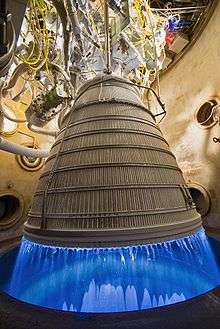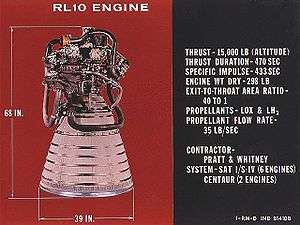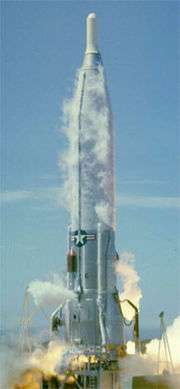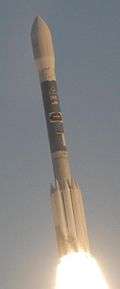RL10
.jpg) An RL10A-4 engine in London's Science Museum | |
| Country of origin | United States of America |
|---|---|
| First flight | 1962 (RL10A-1) |
| Designer | Pratt & Whitney/MSFC |
| Manufacturer |
Pratt & Whitney Space Propulsion Pratt & Whitney Rocketdyne Aerojet Rocketdyne |
| Application | Upper stage engine |
| Associated L/V |
Atlas Titan Delta IV Saturn I |
| Status | In production |
| Liquid-fuel engine | |
| Propellant | Liquid oxygen / liquid hydrogen |
| Mixture ratio | 5.5 or 5.88:1 |
| Cycle | Expander cycle |
| Configuration | |
| Nozzle ratio | 84:1 or 280:1 |
| Performance | |
| Thrust (vac.) | 110 kN (25,000 lbf) |
| Isp (vac.) | 450–465.5 seconds (4.413–4.565 km/s) |
| Burn time | 700 seconds |
| Dimensions | |
| Length | 4.14 m (13.6 ft) w/ nozzle extended |
| Diameter | 2.13 m (7 ft 0 in) |
| Dry weight | 277 kg (611 lb) |
| Used in | |
|
Centaur S-IV DCSS | |
| References | |
| References | [1] |
| Notes | Performance values and dimensions are for RL10B-2. |
The RL10 is a liquid-fuel cryogenic rocket engine used on the Centaur, S-IV, and Delta Cryogenic Second Stage upper stages. Built in the United States by Aerojet Rocketdyne (formerly by Pratt & Whitney Rocketdyne), the RL10 burns cryogenic liquid hydrogen and liquid oxygen propellants, with each engine producing 64.7 to 110 kN (14,545–24,729 lbf) of thrust in vacuum depending on the version in use. The RL10 was the first liquid hydrogen rocket engine to be built in the United States, and development of the engine by Marshall Space Flight Center and Pratt & Whitney began in the 1950s, with the first flight occurring in 1961. Several versions of the engine have been flown, with three, the RL10A-4-2, the RL10B-2, and the RL10C-1 still being produced and flown on the Atlas V and Delta IV.
The engine produces a specific impulse (Isp) of 373 to 470 s (3.66–4.61 km/s) in a vacuum and has a mass ranging from 131 to 317 kg (289–699 lb) (depending on version). Six RL10A-3 engines were used in the S-IV second stage of the Saturn I rocket, one or two RL10 engines are used in the Centaur upper stages of Atlas and Titan rockets, and one RL10B-2 is used in the upper stage of Delta IV rockets.
History
The RL10 was first tested on the ground in 1959, at Pratt & Whitney's Florida Research and Development Center in West Palm Beach, Florida.[2] It was first flown in 1962 in an unsuccessful suborbital test;[3] the first successful flight took place on November 27, 1963.[4][5] For that launch, two RL10A-3 engines powered the Centaur upper stage of an Atlas launch vehicle. The launch was used to conduct a heavily instrumented performance and structural integrity test of the vehicle.[6] The RL10 was designed for the USAF from the beginning as a throttleable motor for the Lunex lunar lander, finally putting this capability to use twenty years later in the DC-X VTOL vehicle.[7]
Improvements
The RL10 has been upgraded over the years. One current model, the RL10B-2, powers the Delta IV second stage. It has been significantly modified from the original RL10 to improve performance. Some of the enhancements include an extendable nozzle and electro-mechanical gimbaling for reduced weight and increased reliability. Current specific impulse is 464 seconds (4.55 km/s).
A flaw in the brazing of an RL10B-2 combustion chamber was identified as the cause of failure for the May 4, 1999, Delta III launch carrying the Orion-3 communications satellite.[8]
Aerojet Rocketdyne is working toward incorporating additive manufacturing into the RL10 construction process. The company conducted full-scale, hot-fire tests on an engine with a printed core main injector in March 2016,[9] and on an engine with a printed thrust chamber assembly in April 2017.[10]
Applications for the RL10
Four modified RL10A-5 engines, all of them with the ability to be throttled, were used in the McDonnell Douglas DC-X.[11]
The DIRECT version 3.0 proposal to replace Ares I and Ares V with a family of rockets sharing a common core stage, recommends the RL10 for the second stage of their proposed J-246 and J-247 launch vehicles.[12] Up to seven RL10 engines would be used in the proposed Jupiter Upper Stage, serving an equivalent role to the Ares V Earth Departure Stage.
Common Extensible Cryogenic Engine

The Common Extensible Cryogenic Engine (CECE) is a testbed to develop RL10 engines that throttle well. NASA has contracted with Pratt & Whitney Rocketdyne to develop the CECE demonstrator engine.[13] In 2007 its operability (with some "chugging") was demonstrated at 11-to-1 throttle ratios.[14] In 2009 NASA reported successfully throttling from 104 percent thrust to eight percent thrust, a record for an engine of this type. Chugging was eliminated by injector and propellant feed system modifications that control the pressure, temperature and flow of propellants.[15]
Advanced Cryogenic Evolved Stage
As of 2009, an enhanced version of the RL10 rocket engine was proposed to power the upper-stage versions of the Advanced Cryogenic Evolved Stage (ACES), a long-duration, low-boiloff extension of existing ULA Centaur and Delta Cryogenic Second Stage (DCSS) technology.[16] Long-duration ACES technology is explicitly designed to support geosynchronous, cislunar, and interplanetary missions as well as provide in-space propellant depots in LEO or at L2 that could be used as way-stations for other rockets to stop and refuel on the way to beyond-LEO or interplanetary missions. Additional missions could include the provision of the high-energy technical capacity for the cleanup of space debris.[17]
SLS Exploration Upper Stage
In April 2016 it was reported NASA has chosen to use a design based on four RL10 engines for the Exploration Upper Stage to be used beginning with the crewed EM-2 mission of the Space Launch System.[18] In October 2016 NASA confirmed these reports when it announced that the Exploration Upper Stage would utilize a new variant of the engine identified as the RL10C-3.[19]
OmegA Upper Stage
In April 2018, Orbital ATK announced it would use two RL10C-5-1 engines for their OmegA to power the upper stage.[20] Blue Origin's BE-3U and Airbus Safran's Vinci were also considered before Aerojet Rocketdyne's engine was selected.
Vulcan Centaur Upper Stage
On May 11, 2018 United Launch Alliance (ULA) announced that Aerojet Rocketdyne would be strategic partner with their RL10C-X upper stage engine for ULA’s next-generation Vulcan Centaur rocket following a competitive procurement process.[21]
Variants
| Version | Status | First flight | Dry mass | Thrust | Isp (ve), vac. | Length | Diameter | T:W | O:F | Expansion ratio | Chamber pressure | Burn time | Associated stage | Notes |
|---|---|---|---|---|---|---|---|---|---|---|---|---|---|---|
| RL10A-1 | Retired | 1962 | 131 kg (289 lb) | 67 kN (15,000 lbf) | 425 s (4.17 km/s) | 1.73 m (5 ft 8 in) | 1.53 m (5 ft 0 in) | 52:1 | 40:1 | 430 s | Centaur A | Prototype [22][23][24] | ||
| RL10A-3 | Retired | 1963 | 131 kg (289 lb) | 65.6 kN (14,700 lbf) | 444 s (4.35 km/s) | 2.49 m (8 ft 2 in) | 1.53 m (5 ft 0 in) | 51:1 | 5:1 | 57:1 | 32.75 bar (3,275 kPa) | 470 s | Centaur B/C/D/E S-IV |
[25] |
| RL10A-4 | Retired | 1992 | 168 kg (370 lb) | 92.5 kN (20,800 lbf) | 449 s (4.40 km/s) | 2.29 m (7 ft 6 in) | 1.17 m (3 ft 10 in) | 56:1 | 5.5:1 | 84:1 | 392 s | Centaur IIA | [26] | |
| RL10A-4-1 | Retired | 2000 | 167 kg (368 lb) | 99.1 kN (22,300 lbf) | 451 s (4.42 km/s) | 1.53 m (5 ft 0 in) | 61:1 | 84:1 | 740 s | Centaur IIIA | [27] | |||
| RL10A-4-2 | In production | 2002 | 167 kg (368 lb) | 99.1 kN (22,300 lbf) | 451 s (4.42 km/s) | 1.17 m (3 ft 10 in) | 61:1 | 84:1 | 740 s | Centaur IIIB Centaur V1 Centaur V2 Centaur DEC |
[28][29] | |||
| RL10A-5 | Retired | 1993 | 143 kg (315 lb) | 64.7 kN (14,500 lbf) | 373 s (3.66 km/s) | 1.07 m (3 ft 6 in) | 1.02 m (3 ft 4 in) | 46:1 | 6:1 | 4:1 | 127 s | DC-X | [30] | |
| RL10B-2 | In production | 1998 | 277 kg (611 lb) | 110 kN (25,000 lbf) | 462 s (4.53 km/s) | 4.14 m (13.6 ft) | 2.13 m (7 ft 0 in) | 40:1 | 5.88:1 | 280:1 | 44.12 bar (4,412 kPa) | 5-m: 1,125 s 4-m: 700 s |
Delta Cryogenic Second Stage | [1][31] |
| RL10B-X | Cancelled | 317 kg (699 lb) | 93.4 kN (21,000 lbf) | 470 s (4.6 km/s) | 1.53 m (5 ft 0 in) | 30:1 | 250:1 | 408 s | Centaur B-X | [32] | ||||
| CECE | Demonstrator project | 160 kg (350 lb) | 67 kN (15,000 lbf), throttle to 5–10% | >445 s (4.36 km/s) | 1.53 m (5 ft 0 in) | [33][34] | ||||||||
| RL10C-1 | In production | 2014 | 190 kg (420 lb) | 101.8 kN (22,890 lbf) | 449.7 s (4.410 km/s) | 2.22 m (7 ft 3 in) | 1.44 m (4 ft 9 in) | 57:1 | 5.5:1 | 130:1 | 2000 s | Centaur SEC | [35][36][37][29] |
Specifications
Original RL10

- Thrust (altitude): 15,000 lbf (66.7 kN)[23]
- Burn time: 470 s
- Design: expander cycle
- Specific impulse: 433 seconds (4.25 km/s)
- Engine weight, dry: 298 lb (135 kg)
- Height: 68 in (1.73 m)
- Diameter: 39 in (0.99 m)
- Nozzle expansion ratio: 40 to 1
- Propellants: liquid oxygen, liquid hydrogen
- Propellant flow: 35 lb/s (16 kg/s)
- Contractor: Pratt & Whitney
- Vehicle application: Saturn I, S-IV 2nd stage, 6 engines
- Vehicle application: Centaur upper stage, 2 engines
Current design

RL10B-2 Specifications
- Thrust (altitude): 24,750 lbf (110.1 kN)[38]
- Design: Expander cycle[39]
- Specific impulse: 464 seconds (4.55 km/s)[38]
- Engine weight, dry: 610 lb (277 kg)[38]
- Height: 163 in (4.14 m)[38]
- Diameter: 87 in (2.21 m)[38]
- Expansion ratio: 280 to 1
- Mixture ratio: 5.88 to 1 [38]
- Propellants: liquid oxygen, liquid hydrogen[38]
- Propellant flow: oxidizer, 41.42 lb/s (20.6 kg/s); fuelm 7.72 lb/s (3.5 kg/s)[38]
- Contractor: Pratt & Whitney
- Vehicle application: Delta III, Delta IV second stage (1 engine)
RL10A-4-2
The other current model, the RL10A-4-2, is the engine used on Centaur upper stage for Atlas V.[38]
Possible successor
In 2012 NASA joined with the US Air Force (USAF) to study next-generation upper stage propulsion, formalizing the agencies joint interests in a new upper stage engine to replace the Aerojet Rocketdyne RL10.
"We know the list price on an RL10. If you look at cost over time, a very large portion of the unit cost of the EELVs is attributable to the propulsion systems, and the RL10 is a very old engine, and there's a lot of craftwork associated with its manufacture. ... That's what this study will figure out, is it worthwhile to build an RL10 replacement?"
— Dale Thomas, Associated Director Technical, Marshall Space Flight Center[40]
From the study, NASA hopes to find a less expensive RL10-class engine for a third stage of the Space Launch System (SLS).[40][41]
USAF hopes to replace the Rocketdyne RL10 engines used on the upper stage of both the Lockheed Martin Atlas V and the Boeing Delta IV, known as Evolved Expendable Launch Vehicles (EELV), that are the primary methods of putting US government satellites into space.[40] This relates to the requirements study of the Affordable Upper Stage Engine Program (AUSEP) liquid rocket engine for use on upper stages of medium- and heavy-class launch vehicles, including the Evolved Expendable Launch Vehicle (EELV) family of launch vehicles.[41]
Engines on display
- An RL10 is on display at the New England Air Museum, Windsor Locks, Connecticut[42]
- An RL10 is on display at the Museum of Science and Industry, Chicago, Illinois[43]
- An RL10 is on display at the U.S. Space & Rocket Center, Huntsville, Alabama[43]
- An RL10 is on display at Southern University, Baton Rouge, Louisiana[44]
- Two RL10 engines are on display at US Space Walk of Fame, Titusville, Florida[45]
- An RL10 is on display in the Aerospace Engineering Department, Davis Hall at Auburn University.
- An RL10A-4 is on display at the Science Museum in London, UK.
See also
- Spacecraft propulsion
- RL60
- RD-0146
- XCOR/ULA aluminum alloy nozzle engine, under development in 2011
References
- 1 2 Wade, Mark (November 17, 2011). "RL-10B-2". Encyclopedia Astronautica. Archived from the original on February 4, 2012. Retrieved February 27, 2012.
- ↑ Connors, p 319
- ↑ "Centaur". Gunter's Space Pages.
- ↑ Sutton, George (2005). History of liquid propellant rocket engines. American Institute of Aeronautics and Astronautics. ISBN 1-56347-649-5.
- ↑ "Renowned Rocket Engine Celebrates 40 Years of Flight". Pratt & Whitney. November 24, 2003. Archived from the original on June 14, 2011.
- ↑ "Atlas Centaur 2". National Space Science Data Center. NASA.
- ↑ Wade, Mark. "Encyclopedia Astronautica—Lunex Project page". Encyclopedia Astronautica. Archived from the original on August 31, 2006.
- ↑ "Delta 269 (Delta III) Investigation Report" (PDF). Boeing. August 16, 2000. MDC 99H0047A. Archived from the original (PDF) on June 16, 2001.
- ↑ "Aerojet Rocketdyne Successfully Tests Complex 3-D Printed Injector in World's Most Reliable Upper Stage Rocket Engine" (Press release). Aerojet Rocketdyne. March 7, 2016. Retrieved April 20, 2017.
- ↑ "Aerojet Rocketdyne Achieves 3-D Printing Milestone with Successful Testing of Full-Scale RL10 Copper Thrust Chamber Assembly" (Press release). Aerojet Rocketdyne. April 3, 2017. Retrieved April 11, 2017.
- ↑ Wade, Mark. "DCX". Encyclopedia Astronautica. Archived from the original on December 28, 2012. Retrieved January 4, 2013.
- ↑ "Jupiter Launch Vehicle – Technical Performance Summaries". Archived from the original on June 8, 2009. Retrieved July 18, 2009.
- ↑ "Common Extensible Cryogenic Engine (CECE)". United Technologies Corporation. Archived from the original on March 4, 2012.
- ↑ "Throttling Back to the Moon". NASA. July 16, 2007. Archived from the original on April 2, 2010.
- ↑ "NASA Tests Engine Technology for Landing Astronauts on the Moon". NASA. January 14, 2009.
- ↑ Kutter, Bernard F.; Zegler, Frank; Barr, Jon; Bulk, Tim; Pitchford, Brian (2009). "Robust Lunar Exploration Using an Efficient Lunar Lander Derived from Existing Upper Stages" (PDF). AIAA.
- ↑ Zegler, Frank; Bernard Kutter (September 2, 2010). "Evolving to a Depot-Based Space Transportation Architecture" (PDF). AIAA SPACE 2010 Conference & Exposition. AIAA. Archived from the original (PDF) on October 20, 2011. Retrieved January 25, 2011.
ACES design conceptualization has been underway at ULA for many years. It leverages design features of both the Centaur and Delta Cryogenic Second Stage (DCSS) upper stages and intends to supplement and perhaps replace these stages in the future. ...
- ↑ Bergin, Chris (April 7, 2016). "MSFC propose Aerojet Rocketdyne supply EUS engines". NASASpaceFlight.com. Retrieved April 8, 2016.
- ↑ "Proven Engine Packs Big, In-Space Punch for NASA's SLS Rocket". NASA. October 21, 2016. Retrieved November 22, 2017.
- ↑ "RL-10 Selected for OmegA Rocket". Aerojet Rocketdyne. April 16, 2018. Retrieved May 14, 2018.
- ↑ "United Launch Alliance Selects Aerojet Rocketdyne's RL10 Engine". ULA. May 11, 2018. Retrieved May 13, 2018.
- ↑ Wade, Mark (November 17, 2011). "RL-10A-1". Encyclopedia Astronautica. Archived from the original on November 15, 2011. Retrieved February 27, 2012.
- 1 2 Bilstein, Roger E. (1996). "Unconventional Cryogenics: RL-10 and J-2". Stages to Saturn; A Technological History of the Apollo/Saturn Launch Vehicles. Washington, D.C.: NASA History Office. Retrieved December 2, 2011.
- ↑ "Atlas Centaur". Gunter's Space Page. Retrieved February 29, 2012.
- ↑ Wade, Mark (November 17, 2011). "RL-10A-3". Encyclopedia Astronautica. Archived from the original on December 6, 2011. Retrieved February 27, 2012.
- ↑ Wade, Mark (November 17, 2011). "RL-10A-4". Encyclopedia Astronautica. Archived from the original on November 15, 2011. Retrieved February 27, 2012.
- ↑ Wade, Mark (November 17, 2011). "RL-10A-4-1". Encyclopedia Astronautica. Archived from the original on November 17, 2011. Retrieved February 27, 2012.
- ↑ Wade, Mark (November 17, 2011). "RL-10A-4-2". Encyclopedia Astronautica. Archived from the original on January 30, 2012. Retrieved February 27, 2012.
- 1 2 "RL10 Engine". Aerojet Rocketdyne.
- ↑ Wade, Mark (November 17, 2011). "RL-10A-5". Encyclopedia Astronautica. Archived from the original on November 15, 2011. Retrieved February 27, 2012.
- ↑ "Delta IV Launch Services User's Guide, June 2013" (PDF). ULA Launch. Retrieved 15 March 2018.
- ↑ Wade, Mark (November 17, 2011). "RL-10B-X". Encyclopedia Astronautica. Archived from the original on November 15, 2011. Retrieved February 27, 2012.
- ↑ "Commons Extensible Cryogenic Engine". Pratt & Whitney Rocketdyne. Archived from the original on March 4, 2012. Retrieved February 28, 2012.
- ↑ "Common Extensible Cryogenic Engine - Aerojet Rocketdyne". www.rocket.com. Retrieved April 8, 2018.
- ↑ "Cryogenic Propulsion Stage" (PDF). NASA. Retrieved October 11, 2014.
- ↑ "Atlas-V with RL10C powered Centaur". forum.nasaspaceflight.com. Retrieved April 8, 2018.
- ↑ "Evolution of Pratt & Whitney's cryogenic rocket engine RL-10". Archived from the original on March 3, 2016. Retrieved February 20, 2016.
- 1 2 3 4 5 6 7 8 9 "RL10B-2" (PDF). Pratt & Whitney Rocketdyne. 2009. Archived from the original (PDF) on March 26, 2012. Retrieved January 29, 2012.
- ↑ Sutton, A. M.; Peery, S. D.; Minick, A. B. (January 1998). "50K expander cycle engine demonstration". AIP Conference Proceedings. 420: 1062–1065. doi:10.1063/1.54719.
- 1 2 3 Roseberg, Zach (April 12, 2012). "NASA, US Air Force to study joint rocket engine". Flight Global. Retrieved June 1, 2012.
- 1 2 Newton, Kimberly (April 12, 2012). "NASA Partners With U.S. Air Force to Study Common Rocket Propulsion Challenges". NASA.
- ↑ "Pratt & Whitney RL10A-1 Rocket Engine". New England Air Museum. Retrieved April 26, 2014.
- 1 2 "Photos of Rocket Engines". Historic Spacecraft. Retrieved April 26, 2014.
- ↑ Colaguori, Nancy; Kidder, Bryan (November 3, 2006). "Pratt & Whitney Rocketdyne Donates Model of Legendary Rl10 Rocket Engine to Southern University" (Press release). Pratt & Whitney Rocketdyne. PR Newswire. Retrieved April 26, 2014.
- ↑ "American Space Museum & Space Walk of Fame". www.facebook.com. Retrieved April 8, 2018.
Bibliography
- Connors, Jack (2010). The Engines of Pratt & Whitney: A Technical History. Reston. Virginia: American Institute of Aeronautics and Astronautics. ISBN 978-1-60086-711-8.
External links
| Wikimedia Commons has media related to RL10. |


